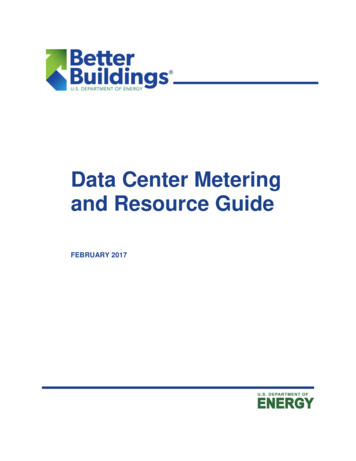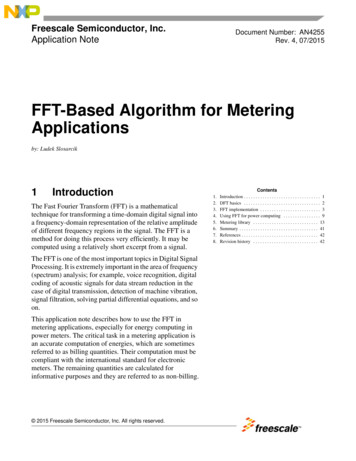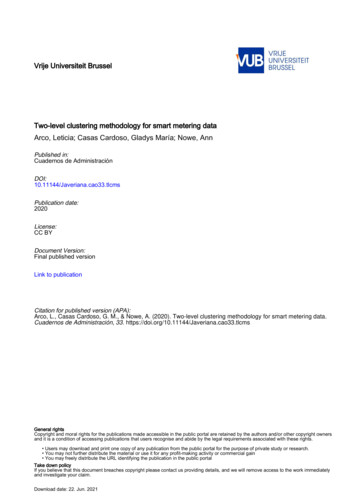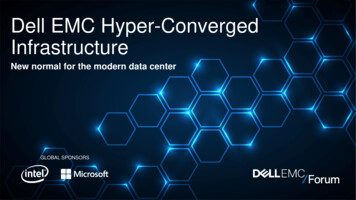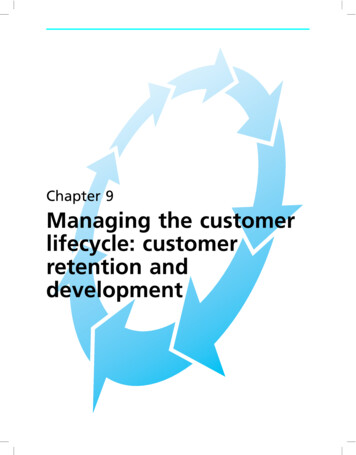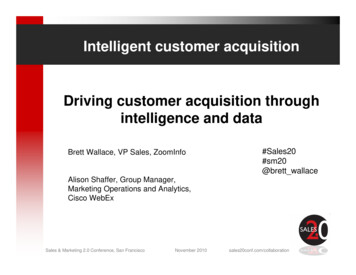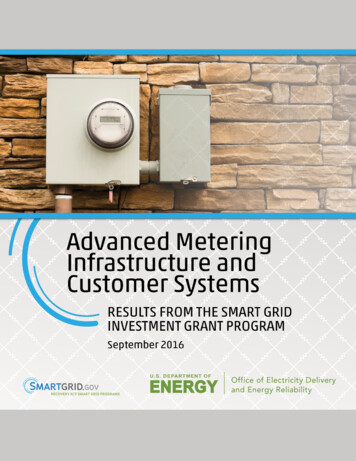
Transcription
Table of ContentsExecutive Summary.4Major Findings.4Key Lessons and Conclusions .6Future Directions and Next Steps .81 AMI and Customer System Deployment in the Smart Grid Investment Grants .91.1 AMI and Customer Technologies and Functions Deployed in SGIG .10Advanced Metering Infrastructure.11Customer Systems .15Time-Based Rates and Demand-Side Programs .161.2 Project Build and Impact Metrics .171.3 Key Data Limitations and Considerations .172 Major AMI Findings: Improved Customer Service and Reduced Operational Costs . 192.1 Automated Billing and Remote Meter Reading, Connection, and Disconnection .19Key Result: Operations and Maintenance Cost Savings .21Key Result: Improved Accuracy and Customer Services .212.2 Online Bill Payments and Pre-Pay Billing Plans .23Key Result: Enhanced Revenues and Reduced Bad Debt Write-Offs .232.3 Meter Tampering and Theft Detection .24Key Result: Enhanced Revenue Collection .242.4 Outage Detection and Management .25Key Result: More Accurate Outage Location to Support Rapid Restoration .25Key Result: Improved Outage Information Sharing and Customer Notification .262.5 Voltage Monitoring .26Key Result: Enhanced Voltage and Reactive Power Management .27Case Study: CenterPoint Energy .28Case Study: Oklahoma Gas and Electric (OG&E) .30Case Study: Central Maine Power (CMP) .33Case Study: Potomac Electric Power Company (PEPCO) – District of Columbia .36Case Study: Electric Power Board of Chattanooga (EPB) .38Case Study: Talquin Electric Cooperative (TEC) .40Case Study: Central Lincoln Peoples Utility District .42Case Study: Tri-State Electric Membership Corporation .442AMI and Customer Systems: Results from the SGIG Program
3 Major Customer System Findings: New Rates and Demand-Side Management Capabilities . 473.1 Time-Based Rates and Direct Load Control .47Key Result: Reduced Peak Demand and Overall Consumption .49Key Result: Customer Bill Savings .503.2 Distributed Energy Resource and Electric Vehicle Integration .51Key Result: Improved Integration and Billing for DERs and EV Charging .51Key Result: New Insights into Electric Vehicle Charging Patterns .52Case Study: Sacramento Municipal Utility District (SMUD) .53Case Study: Glendale Water and Power (GWP) .56Case Study: Burbank Water and Power (BWP) .58Case Study: Sioux Valley Energy (SVE) .604 Key Lessons and Conclusions .624.1 Multiple Factors Affect the AMI Business Case.624.2 Communications Systems that Serve Smart Grid Functions Beyond AMI Deliver More Value .634.3 Systems Integration is a Critical Linchpin for AMI Impacts and Benefits .64Effective AMI, MDMS, CIS, and Billing Integration Greatly Enhance Billing and Metering .64OMS and DMS Integration Increases the Value of Smart Meters .65Customer Systems Integration Involves Interoperability Challenges .66AMI and DA Integration Boosts the Value of Individual Technologies .674.4 Workforce Management and Training are Critical to AMI and DSM Success .674.5 Cybersecurity and Interoperability Are Integral to Smart Grid .69Lessons Learned and Best Practices from the 2012 Smart Grid Cybersecurity Information Exchange .704.6 Designing and Promoting Effective Web Portals Involved Several Challenges .714.7 Customer Education Improves Demand Response Programs.715 Future Directions and Next Steps .725.1 SGIG Utilities Largely Plan to Expand AMI and Customer System Investments.725.2 AMI and Customer System Projects Highlighted Continuing R&D Challenges .74APPENDIX A.Where to Find Additional Information .76Approach to Analysis and Data Collection .79Supporting Build Metrics Data .83Supporting Impact Metrics Data .95Acronyms and Abbreviations .973
Executive SummaryAdvanced metering infrastructure (AMI) is an integratedsystem of smart meters, communications networks, anddata management systems that enables two-waycommunication between utilities and customers. Thesystem provides a number of important functions thatwere not previously possible or had to be performedmanually, such as the ability to automatically andremotely measure electricity use, connect anddisconnect service, detect tampering, identify and isolateoutages, and monitor voltage. Combined with customertechnologies, such as in-home displays andprogrammable communicating thermostats, AMI alsoenables utilities to offer new time-based rate programsand incentives that encourage customers to reduce peakdemand and manage energy consumption and costs.This report shares key results and benefits from the 70SGIG projects implementing AMI and customer systemtechnologies, and also documents lessons learned ontechnology installation and implementation strategies.With this report, the U.S. Department of Energy (DOE)aims to further accelerate grid modernization by helpingdecision makers better assess the benefits and costs ofAMI and customer system investments and learn fromleading-edge utilities.The Smart Grid Investment Grant (SGIG) ProgramThe American Recovery and Reinvestment Act(ARRA) of 2009 provided DOE with 3.4 billion toinvest in 99 SGIG projects to modernize theelectric grid, strengthen cybersecurity, improveinteroperability, and collect smart grid impactdata. Electricity industry recipients matched orexceeded this investment dollar-for-dollar.Deployment of AMI and customer systemsaccounted for more than two-thirds of the 7.9billion total SGIG investment. SGIG projectsinvested in new communication networks andinformation management systems that form thebackbone of AMI, and tested: 16.3 million smart meters—29% of total U.S.smart meters installed by 2014 250,000 programmable communicatingthermostats (PCTs) 400,000 direct load control (DLC) devices 100,000 in-home displays (IHDs) 417,000 participants in time-based rate andincentive programs 49 customer web portalsMajor FindingsSGIG projects demonstrated that AMI and customer systems can achieve substantial grid impacts andbenefits for customers and utilities, including: Reduced costs for metering and billing from fewer truck rolls, labor savings, more accurateand timely billing, fewer customer disputes, and improvements in operational efficiencies. More customer control over electricity consumption, costs, and bills from greater use of newcustomer tools (e.g., web portals and smart thermostats) and techniques (e.g., shifting demandto off-peak periods). Lower utility capital expenditures and customer bill savings resulting from reduced peakdemand and improvements in asset utilization and maintenance. Lower outage costs and fewer inconveniences for customers from faster outage restorationand more precise dispatching of repair crews to the locations where they are needed.4AMI and Customer Systems: Results from the SGIG Program
Operations and maintenance (O&M) cost savings from remote billing and metering services is amajor benefit stream for the AMI business case. Operational efficiencies enhanced revenuecollection and improved customer service and satisfaction. Remote meter reading generates more timely,accurate bills, eliminating the need for manualtruck rolls and labor to read meters,connect/disconnect service, and diagnosemany meter issues. Large-scale deploymentsand utilities with low customer densities orgeographically dispersed territories had thegreatest savings potential.Over a 3-year period, SGIG projects cumulatively: 1Saved 316 million in O&M costs—anaverage of 16.6 million per projectreportingAvoided 13.7 million truck rolls and 68.3million vehicle-miles traveled Utilities with AMI are now able to fulfill remoteservice connection and disconnection orders inhours instead of days. Many utilities improved billing accuracy,reduced customer complaints, and used AMI data to resolve billing disputes faster. AMI enablesutilities to proactively identify and notify customers of unusual usage patterns in advance ofbills. Pre-pay billing plans helped customers to manage consumption and costs. Several utilitiesimproved revenue collection and costrecovery by implementing pre-pay billingCenterPoint Energy reported total AMIprograms that can help customers avoidcost savings of more than 61 million fromdefaulting on bills.2012-2014. Tamper detection functionsNew capabilities for tamper and theftalone prevented revenue losses exceedingdetection through AMI deployments enhance 450,000 in 2012 and 130,000 in 2014.revenue collection and lower costs. Saved an estimated 15,160 tons of CO2equivalent emissionsAMI became an important contributor to outage management, service restoration, and voltagemonitoring for many SGIG projects, particularly those that implemented AMI alongsideinvestments in distribution automation technologies. AMI enables utilities to isolate outages fasterand dispatch repair crews more precisely,reducing outage duration, limitinginconvenience, and reducing labor hours andtruck rolls for outage diagnosis andrestoration. Utilities facing regular, severe weather events and storm-induced outages have greaterincentives for using AMI for outage management than those that do not.Burbank Water and Power sends last-gaspalerts from its smart meters to the OutageManagement System within 2 minutes,where its Geographic Information Systemupd
Case Study: Potomac Electric Power Company (PEPCO) – District of Columbia .36 Case Study: Electric Power Board of Chattanooga (EPB). 38 Case Study: Talquin Electric Cooperative (TEC) . 40 Case Study: Central Lincoln Peoples Utility District . 42 Case Study: Tri-State Electric Membership Corporation . 44. 3 3 Major Customer System Findings: New Rates and DemandSide .

